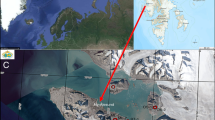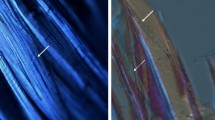Abstract
Plate counts, scanning electron microscopy, and direct observations were utilized to determine successional trends of different groups of microorganisms onProcambarus versutus (Hagen) exoskeletons incubatedin situ in a second-order, acidic woodland stream in Northwest Florida. Plate counts and SEM observations indicated a definite successional pattern dominated in numbers initially by the nonbranching bacteria, followed by the actinomycetes. The greatest number of fungal propagules coincided with the least number of bacterial colony-forming units. Chitinoclastic bacterial colonizers increased on the substrate throughout the study, comprising as much as 88% of the total bacterial community during the final stages of chitin decomposition. Scanning electron micrographs taken over the duration of the study revealed the abundance of an actinomycete, identified as a species ofStreptomyces, on the exoskeleton. Enumeration of microorganisms in the stream sediment was also performed in conjunction with the exoskeleton analysis. Relatively constant numbers of bacteria and fungi were observed, with chitinoclastic bacteria comprising between 3 and 11% of the total sediment bacterial community.
Similar content being viewed by others
References
Bärlocher, F. and B. Kendrick: Dynamics of the fungal population on leaves in a stream. J. Ecol.62, 761–791 (1974)
Chan, J. C.: The occurrence, taxonomy and activity of chitinoclastic bacteria from sediment, water and fauna of Puget Sound. Ph.D. thesis. University of Washington, Seattle, WA (1970)
Goodfellow, M., and T. Cross: Actinomycetes. In E. B. Gareth Jones (ed): Recent Advances in Aquatic Mycology, pp. 673–698. John Wiley and Sons, New York (1974)
Goodrich, T. D., and R. Y. Morita: Incidence and estimation of chitinase activity associated with marine fish and other estuarine samples. Mar. Biol.4, 349–353 (1977)
Gottlieb, D.: General consideration and implications of the Actinomycetales. In G. Sykes and F. A. Skinner (eds.): Actinomycetes; Characteristics and Practical Importance, pp. 1–10. Academic Press, London (1973)
Gray, T. R. G., and P. Baxby: Chitin decomposition in soil. II. The ecology of chitinoclastic microorganisms in forest soil. Trans. Br. Mycol. Soc.51, 292–309 (1968)
Hankin, L., and S. L. Anagnostakis: The use of solid media for detection of enzyme production by fungi. Mycologia67, 597–607 (1975)
Hood, M. A., and S. P. Meyers: The biology of aquatic chitinoclastic bacteria and their chitinolytic activities. La mer (Bulletin de la Societe franco-japonaise d'oceanographie)11, 1–17 (1973)
Hood, M. A., and S. P. Meyers: Rates of chitin degradation in an estuarine environment. J. Oceanogr. Soc. Jpn.33, 328–334 (1977)
Kaushik, N. K., and H. B. N. Hynes: The fate of dead leaves that fall into streams. Arch. Hydrobiol.68, 465–515 (1971)
Mason, C. F.: Relative importance of fungi and bacteria in the decomposition ofPhragmites leaves. Hydrobiologia51, 65–69 (1976)
Mordarska, H., and M. Mordarski: Chemotaxic characters and classification of some nocardioform bacteria. J. Gen. Microbiol.71, 77–86 (1972)
Peterson, R. C., and K. W. Cummins: Leaf processing in a woodland stream. Freshwater Biol.4, 343–368 (1974)
Rodina, A. G.: Methods in Aquatic Microbiology. University Park Press, Baltimore (1972)
Suberkropp, K., and M. J. Klug: Fungi and bacteria associated with leaves during processing in a woodland stream. Ecology57, 707–719 (1976)
Triska, F. J.: Seasonal distribution of aquatic hyphomycetes in relation to the disappearance of leaf litter from a woodland stream. Ph.D. thesis, University of Pittsburgh, Pittsburgh, PA (1970)
Veldkamp, H.: A study of the aerobic decomposition of chitin by microorganisms.Meded. Landbouwhogesch. Wageningen 55, 127–174 (1955)
Wames, C. F., and C. I. Randies: Preliminary studies on chitin decomposition in Lake Erie sediments. Ohio J. Sci.77, 224–230 (1977)
Willoughby, L. G.: Decomposition of litter in freshwater. In C. H. Dickinson and G. J. F. Pugh (eds.): Biology of Plant Litter Decomposition, Vol. 2, pp. 659–681. Academic Press, London (1974)
Willoughby, L. G.: Freshwater actinomycetes. In E. B. Gareth Jones (ed.): Recent Advances in Aquatic Mycology, pp. 673–698. John Wiley and Sons, New York (1976)
ZoBell, C. E., and S. C. Rittenberg: The occurrence and characteristics of chitinoclastic bacteria in the sea. J. Bacteriol.35, 275–287 (1938)
Author information
Authors and Affiliations
Rights and permissions
About this article
Cite this article
Aumen, N.G. Microbial succession on a chitinous substrate in a woodland stream. Microb Ecol 6, 317–327 (1980). https://doi.org/10.1007/BF02010494
Issue Date:
DOI: https://doi.org/10.1007/BF02010494




